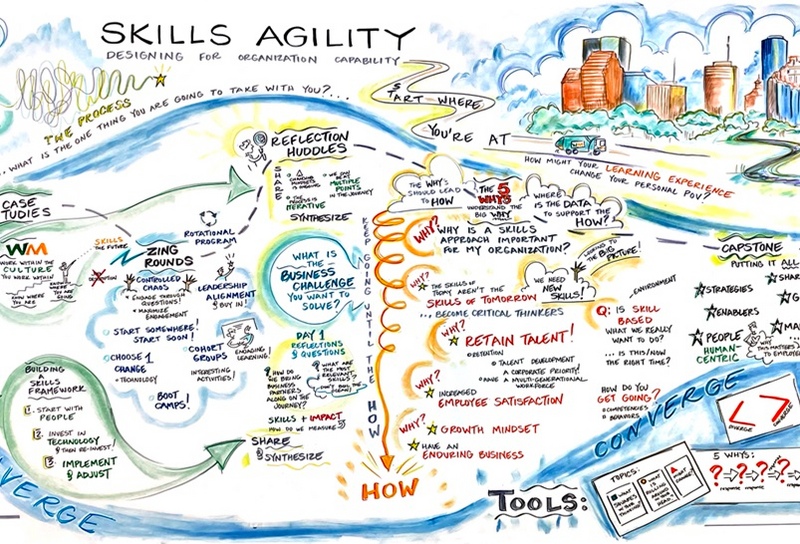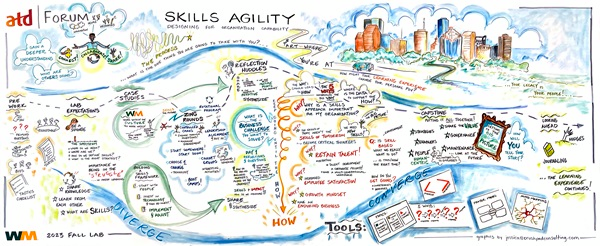ATD Blog
The Skills Approach Conundrum: Expanding One’s Point of View
Tue Dec 05 2023

The headlines on building a skills approach are rampant! Every day it ranges from what technology to use to ideas for hiring based on skills not degrees. Among all these blogs and webinars, are you still wondering where to get started or what to do for your organization?
Recently, the members of the ATD Forum held their annual fall lab. This year’s theme was Skills Agility: Using a Skills Focus to Design for Organizational Capability. The lab was hosted by member WM at its headquarters in Houston, and members from diverse organizations gathered to engage in a collaborative environment to benchmark and learn from peers about how using skills for workforce planning, talent management, and employee development can contribute to engagement, retention, and productivity.
The format for forum labs is similar to an incubator, where attendees are exposed to lots of tools, tactics, techniques, research, and strategies others are using. Using case studies, design thinking tools, and reflection, attendees engage in activities to ask questions and gain new insights. However, this lab didn’t start on-site. For the three weeks leading up to the lab, members were asked to think about priming questions, write their point of view on a skills approach, and provide the references they use to learn about skills practices. These were compiled and shared. Additionally, there were several related surveys, including one on paying for skills, and a virtual discussion where two members shared their skills-based practices.
To dive a little deeper and help members benchmark, a checklist of more than 50 tactics related to a skills approach, ranging from capability academies to lattice pathing to employee talent profiles, was provided to all members. Going forward, members can continue to use the checklist for tactics, but more importantly, it serves as a refence for connecting with others about their tactics.
On-site, forum labs are fast-and-furious opportunities to connect, collaborate, and share. The sessions include presentations from members of various industries, organization sizes, and geographies. And attendees have opportunities to collaborate using interactive design thinking tools and intentional small group reflection huddles to sort, sift, and synthesize all of the information shared.
Forum labs are not about one-size-fits-all solutions. They are about experiencing a vast array of options. At the end, attendees collectively work through a capstone activity to gain a deeper understanding of the topic to expand their point of view and take actionable steps back to their respective organizations.
One of the activities at the 2023 Fall Lab included the 5 Whys, a simple tool to uncover the root cause or the driver for an action. The activity’s results were varied; however, some of the common drivers for focusing on skills that surfaced included:
Attracting candidates with the right skills
Creating an environment where employee want to stay
Labor and skill shortages for the jobs to be done
Growth of the business to include the impact of disruptive technologies
Outpacing the competition in light of changing business needs.
Expanding one’s point of view includes building your knowledge base, which naturally includes asking more questions. After a day of immersion in member case studies and listing drivers, attendees documented their top questions. The questions ranged from how to get started, especially how to determine the critical roles for the future, to determining the skills needed and learning what frameworks are available to jumpstart the journey. These questions surfaced: What is a skills approach? Is there a common definition? What is the difference between what we have been doing with competencies and knowledge, skills, and abilities (KSAs) and this new approach? There were also questions related to how current content might be more skills related and how to measure the success of a skills approach with an emphasis on its effectiveness and productivity.
Here's a summary of the way attendees put it all together in the capstone:

1. Start somewhere. An easy place to start is to assess and document where you are—not only with skills tactics and techniques but also with the current tech ecosystem and capabilities. What are you already doing, and how are you doing it?
2. Be clear on where you want to be in the near and far future. For example, what is your vision, based on your organizational culture, industry, labor trends, and the level of innovation needed to stay competitive in your markets? Conduct research. Benchmark those companies with mature skills processes. Ask questions. If not available, create internal operational definitions for all of the skills-related terms and use them consistently in the organization.
3. Know your big WHY by determining the top business challenges. Focus on the top priorities. Pay attention to your data. Create awareness by starting conversations with others in the organization about how focusing on skills might address the current challenge and help the organization be more prepared for the future.
4. Develop a people-first strategy to address the primary pain points to close the gaps. Remember technology is just an enabler, not a driver. Where do you need to build skills, and where should you buy skills?
5. Start small with pilots. Do not try to boil the ocean. For example, you might want to start with a business unit who sees value in enhancing skills and is ready to partner with the L&D team. Assess the results and learn from the experiences. Iterate.
6. Celebrate small wins.
7. Make continuous improvements to get better at getting better.
The takeaways from the attendees were revealing and should be helpful to all talent leaders. First was the sense that while they represented so many different industries and different places along their skills journeys, they were all in the same boat with similar challenges, especially related to future readiness. Second, the solution looks different depending on your culture, industry, employee base, and so forth. And finally, the solutions for various segments of your employee base may differ.
